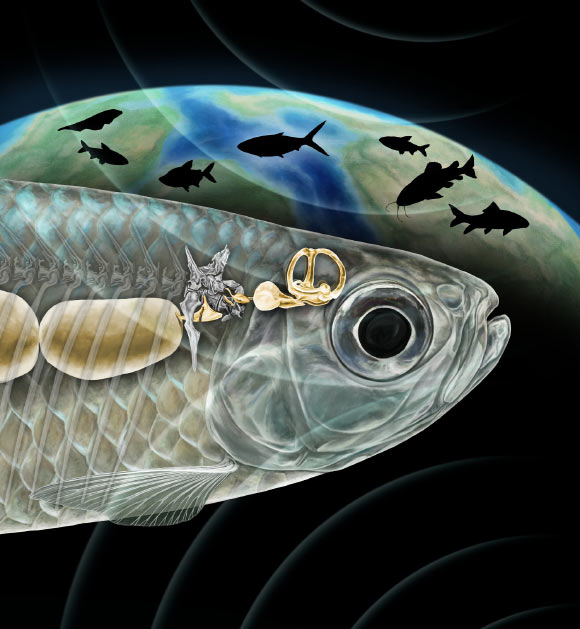The fish supergroup Otophysi, known for their enhanced hearing, comprises two-thirds of living freshwater fish species. Previously, they were thought to have originated in freshwater before the breakup of the supercontinent Pangea, implying a nearly 80-million-year gap between the origin and oldest known fossil. However, the discovery of Acronichthys maccognoi — a newly-described freshwater otophysan species that lived during the Late Cretaceous epoch — challenges this view.

An artist’s reconstruction of the Weberian apparatus in Acronichthys maccognoi; the Weberian structure (gold-colored bones at center) arose from a rib (shown in gray attached to several back bones in the spine) and connect the fish’s air bladder (left) with the inner ear (right). Image credit: Ken Naganawa, University of California, Berkeley.
Ears that work underwater require a different anatomy than ears that detect sound traveling through the air.
Many land vertebrates evolved an eardrum-like structure that vibrates in response to sound waves.
That eardrum moves a Rube Goldberg-like array of bones in the middle ear — in humans, the malleus, incus and stapes — that amplify the sound and poke the fluid-filled inner ear, which jiggles and eventually jostles hairs that send signals to the brain.
But sound waves in water go right through a fish, which has a similar density to the surrounding water.
So fish developed a bladder filled with air — essentially a bubble — that vibrates in response to sounds passing through the fish.
Those vibrations are transferred to the fish’s inner ear in a rudimentary way in most saltwater fish, which limits their hearing to bass notes below about 200 Hz.
Otophysan fish, however, developed bony ‘ossicles’ between the air bladder and the inner ear — a system called the Weberian apparatus — to amplify and extend the frequency range the ears can detect. Zebrafish, for example, can hear frequencies up to 15,000 Hz, not far from the 20,000 Hz limit of humans.
Why these fish need to hear high frequencies is a mystery, though it may be because they live in diverse and complicated environments, from rushing streams to static lakes.
“The reason Acronichthys maccagnoi is so exciting is that it fills a gap in our record of the otophysans supergroup,” said Professor Neil Banerjee, a researcher at Western University.
“It is the oldest North America member of the group and provides incredible data to help document the origin and early evolution of so many freshwater fish living today.”
Acronichthys maccagnoi lived during the Late Cretaceous approximately 67 million years ago.
The authors captured micro-CT scans of the 4-cm-long fossil and examined its Weberian structure.
They also analyzed the genomes and morphology of modern fish to revise the genealogy of freshwater fish, and also simulate the frequency response of the fossil fish’s middle ear structure.
Their model suggests that, even 67 million years ago, otophysan fish had nearly as sensitive hearing as zebrafish do today.
“We weren’t sure if this was a fully functional Weberian apparatus, but it turns out the simulation worked,” said Dr. Juan Liu, a paleontologist at the University of California, Berkeley.
“The Weberian apparatus has just a little bit lower output power, which means lower sensitivity, compared to a zebrafish.”
“But the peak, the most sensitive frequency, is not too much lower than zebrafish — between 500 and 1,000 Hz — which is not too bad at all and which means the higher frequency hearing should have been achieved in this old otophysan fish.”
The discovery suggests the transition from marine to freshwater species happened at least twice during otophysans’ evolution.
The researchers estimate a new divergence time for otophysans from marine to freshwater species at around 154 million years ago (Late Jurassic epoch), after Pangea began to break apart about 200 million years ago.
“Dinosaurs are pretty exciting, so a lot of time and effort has been focused on them so we know a lot about what they were like, but we’ve only scratched the surface when it comes to understanding the diversity of prehistoric freshwater fish,” said Dr. Don Brinkman, curator emeritus at the Royal Tyrell Museum.
“There’s still so much we don’t know, and a fossil site right here in Canada is giving us the key to understanding the origins of groups that now dominate rivers and lakes around the world.”
A paper describing the results was published October 2 in the journal Science.
_____
Juan Liu et al. 2025. Marine origins and freshwater radiations of the otophysan fishes. Science 390 (6768): 65-69; doi: 10.1126/science.adr4494







